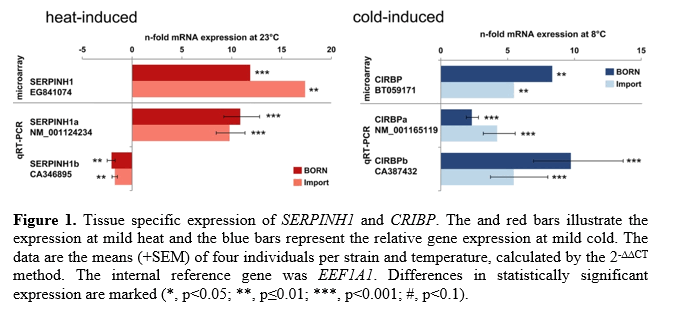Transcriptome data suggest SERPINH1 and CIRBP as molecular markers for thermal stress characterization in rainbow trout (Oncorhynchus mykiss)
Introduction
Seasonal high water temperature amplitudes are the normality in the brackish coastal water of the Southern Baltic Sea region and neighboring lakes and rivers. Hence, regional rearing conditions for rainbow trout preferring temperatures between 15°C and 18.6°C (McCullough, 2001) for growth are often not optimal. Fishes are poikilothermic and therefore reliant on water temperature; Brett defined water temperature as "abiotic master factor" for fish (Brett, 1971). We assume that the usual practice of keeping imported rainbow trout in locally open or semi-open aquaculture can be stressful for the fish and negatively influence their welfare. Hypothesizing that local adaptation positively influences stress performance, we conducted transcriptome analyses to detect differences in the temperature-induced gene expression in the rainbow trout strain BORN (Born, Germany) selected for survival under regional conditions (Anders, 1986; Rebl et al., 2014) in addition to a common imported strain selected for growth (Steelhead II-WA; Troutlodge, Tacoma, USA). Aim of this study is the identification of kidney genes that are characteristic for thermal stress and which can be used as molecular markers for the simple and fast indication of temperature stress in rainbow trout aquaculture. Furthermore, the analyses provide initial gene data potentially useable for selection and breeding.
Materials and methods
Rainbow trout of strains BORN and Import simultaneously grown under identical rearing conditions (temperature, freshwater, and feeding) were transferred into two separate 300-L tanks. A partial dorsal fin cut identified BORN trout within the mix of 10 fish per strain and tank. Fish were first adapted to 15°C for two weeks and afterwards adapted to 8°C and 23°C, respectively, by temperature adjustment of 1°C per day. One week after attaining the moderate stress target temperature, trout were sampled. RNA was isolated from selected tissues (kidney, gills, muscle, and brain) and used as probe in a comparative one-color microarray analysis on 4x44K Salmon Gene Expression Microarray slides (Agilent Technologies). Performing standardized normalization and primary data analyses (including log2-transformation, M versus A and boxplot analyses) including statistical testing (Bonferoni correction and Principal Component Analyses - PCA), calculation of gene expression and fold-change values as well as gene annotation identified significant (FC ≥ 3) differently expressed genes. STARS bioinformatics package and Ingenuity Pathway Analyses (IPA) classified genes by their functions and quantitative real time PCR (qPCR) validated selected microarray results.
Results and discussion
Independent from temperature or strain, the microarray analyses suggested a tissue-specific gene regulation. Analyses of kidney tissue revealed a moderate gene expression activity; however, the gene expression was strain-specific and temperature-dependent. In total, there were more genes regulated in imported trout (368 features) than in strain BORN (294 features). In general, we found more genes significantly expressed in response to cold (8°C, 257 features) compared to moderate heat stress (23°C, 169 features). Forty-five percent of the overrepresented (FC ≥ 3) features were annotated genes. We identified numerous gene duplication problems. The functional classification by IPA and STARS enriched the temperature-regulated genes in GO term pathways such as immune response, cell death and stress response, and metabolism. Heat maps of top up- or down-regulated genes identified SERPINH1 (serpin peptidase inhibitor, clade H (heat shock protein 47), member 1) in both strains as one of the top temperature-dependent upregulated genes at 23°C compared to fish kept at 8°C. The gene CIRBP (cold inducible RNA binding protein) on the other hand was upregulated at 8°C compared to trout kept at 23°C (Figure 1). The regulation of both genes was significantly strain-specific with a stronger SERPINH1 gene expression in import trout and a stronger CIRBP gene expression in BORN trout compared to the respective other strain. Deeper gene analyses revealed the gene variants SERPINH1a and b and CIRBPa and b. Quantitative PCR of SEPINH1a transcript levels validated the microarray-predicted data, whereas the variant b was significantly down-regulated. In case of CIRBP, both gene variants a and b were upregulated. However, CIRBPa was more strongly expressed in import trout and CIRBPb was more strongly expressed in BORN trout. Quantification of SERPINH1a and CIRBP in kidney RNA samples at the control temperature of 15°C supported our findings and the selected experimental approach. The SERPINH1a gene regulation and its functions (e.g. Nakai et al., 1992; Satoh et al., 1996) suggest the gene as a universal marker for heat stress. Gracey and co-workers suggested CIRBP already as a marker for cold shock (Gracey et al., 2004). Our data support this idea and recommend CIRBP as universal cold stress marker.
Funding
European Fisheries Fund and the Ministry of Agriculture, the Environment and Consumer Protection Mecklenburg-Western Pomerania (pilot project BORN trout # VI 560 7308-4).
Anders, E., 1986. Stand der Züchtung und Reproduktion brackwasseradaptierter Regenbogenforellenbestände im Küstenbereich der DDR. Fischerei-Forschung 24: 72.
Brett, Jr., 1971. Energetic Responses of Salmon to Temperature. A Study of Some Thermal Relations in the Physiology and Freshwater Ecology of Sockeye Salmon (Oncorhynchus nerka). Integr Comp Biol 11: 99-113.
Gracey, A. Y., Fraser E. J., Li W., Fang Y., Taylor R. R., Rogers J., Brass A., 2004. Coping with cold: An integrative, multitissue analysis of the transcriptome of a poikilothermic vertebrate. Proc Natl Acad Sci U S A 101: 16970-16975.
McCullough, D., Spalding, S., Sturdevant, D., Hicks, M., 2001. Summary of Technical Literature Examining the Physiological Effects of Temperature on Salmonids. United States Environmental Protection Agency EPA-910-D-01-005 pp114.
Nakai A., 1992. Involvement of the stress protein HSP47 in procollagen processing in the endoplasmic reticulum. J Cell Biol 117: 903-914.
Rebl A, Korytář T, Köbis JM, et al. (2014) Transcriptome profiling reveals insight into distinct immune responses to Aeromonas salmonicida in gill of two rainbow trout strains. Mar Biotechnol (NY) 16:333-348.
Satoh M, Hirayoshi K, Yokota S, et al. (1996) Intracellular interaction of collagen-specific stress protein HSP47 with newly synthesized procollagen. J Cell Biol 133:469-483.
